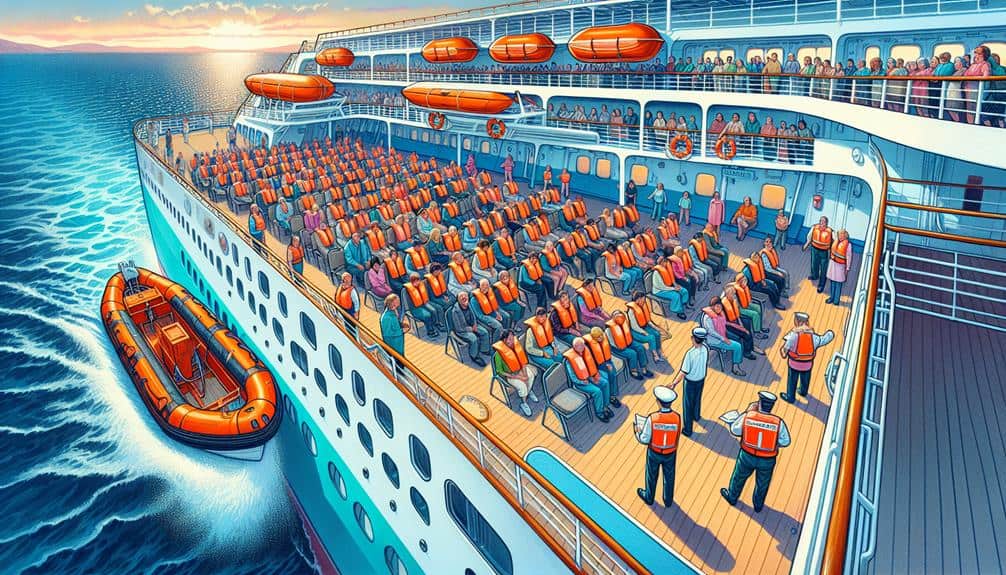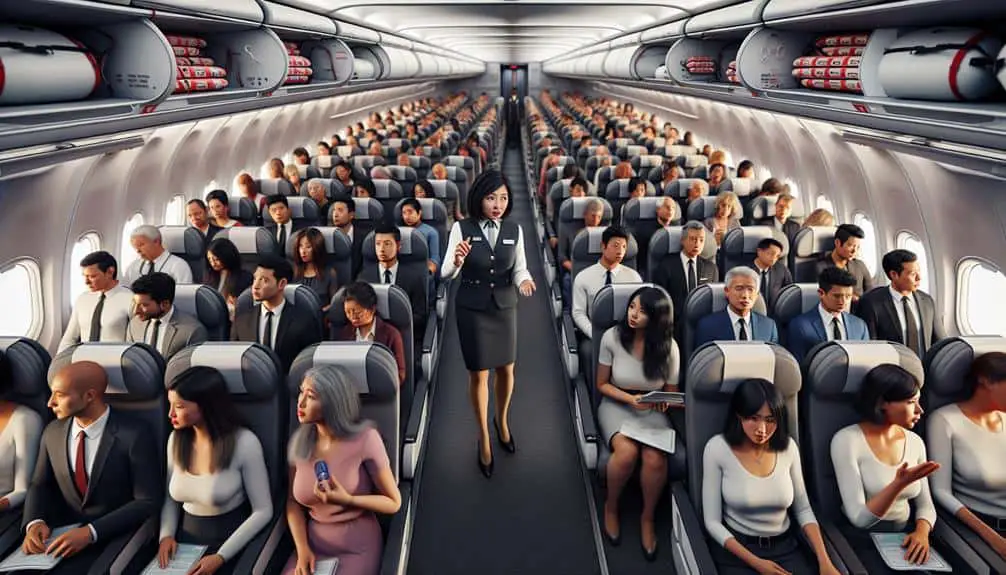Guarantee cruise ship safety by concentrating on crew training, regular inspections, emergency drills, adherence to safety standards, and passenger awareness programs. Crew members need comprehensive training in emergency procedures and effective communication. Routine safety assessments assess adherence, focusing on critical areas like fire safety. Emergency response drills are vital for prompt actions during crises. Adherence to international safety standards is essential for passenger and crew safety. Passenger safety awareness programs enhance preparedness. Implement these tips for a safer cruise experience.
Key Points
- Ensure crew members undergo comprehensive safety training for effective emergency response.
- Conduct regular safety inspections to identify and address potential hazards on board.
- Practice emergency response drills to enhance crew coordination and preparedness.
- Comply with international safety standards to guarantee passenger and crew safety.
- Implement passenger safety awareness programs for enhanced emergency preparedness.
Safety Training for Crew Members
To guarantee the highest level of safety on board, crew members undergo rigorous training programs. These programs cover emergency procedures, crisis management, and passenger assistance protocols. Crew communication plays an essential role in ensuring that all staff members are well-informed and able to coordinate effectively during any emergency situation.
Through training, crew members learn how to communicate clearly and efficiently with each other, as well as with passengers. This ensures a swift and organized response to any hazard that may arise.
Another critical aspect of crew training is hazard recognition. Crew members are trained to identify potential hazards on board, such as fire risks, medical emergencies, or inclement weather conditions. By being able to recognize these hazards early on, the crew can take proactive measures to prevent accidents and ensure the safety of everyone on the cruise ship.
Training in hazard recognition also involves familiarizing crew members with safety equipment and protocols to mitigate risks effectively.
Regular Safety Inspections on Board
Regular safety inspections on board are conducted systematically to evaluate and guarantee the cruise ship's compliance with safety standards and regulations. These inspections follow strict inspection protocols designed to cover all critical areas of the ship, including fire safety systems, lifeboats, emergency exits, and more. By adhering to these inspection protocols, cruise ships can make certain that all safety measures are up to date and in proper working condition.
Maintenance schedules play an important role in these inspections, as they dictate when different safety components need to be checked, serviced, or replaced. Regular maintenance helps prevent malfunctions and ensures that safety equipment functions as intended during emergencies. Inspectors pay close attention to the ship's structural integrity, machinery, electrical systems, and safety equipment to identify any potential risks and address them promptly.
Following these meticulous inspection protocols and adhering to maintenance schedules are essential practices to maintain a high level of safety on board cruise ships. It's through these thorough inspections that potential hazards can be identified and mitigated, ultimately guaranteeing the safety and well-being of all passengers and crew members.
Emergency Response Drills and Plans
Inspectors make sure that emergency response drills and plans are meticulously developed and regularly practiced on board cruise ships to guarantee swift and effective actions in critical situations. Emergency response procedures are essential components of ensuring passenger and crew safety. These plans outline specific protocols for various emergencies such as fires, man overboard incidents, or medical emergencies. Simulation exercises are conducted frequently to test the efficiency of these procedures and to train the crew on proper responses. During these drills, crew members are assigned specific roles and responsibilities to ensure a coordinated and efficient response in real emergencies.
The simulation exercises help to identify any weaknesses in the emergency response plans and allow for adjustments to be made accordingly. Regular practice enhances the crew's familiarity with the procedures, enabling them to act quickly and decisively when faced with an actual emergency. By prioritizing the development and practice of emergency response drills and plans, cruise ships can better safeguard the well-being of everyone on board.
Compliance With International Safety Standards
Ensuring compliance with international safety standards is a paramount requirement for cruise ship operators to guarantee the utmost safety of passengers and crew on board. Safety protocols play a vital role in maintaining a secure environment at sea. It's imperative for cruise lines to adhere to strict regulatory compliance set by international maritime organizations such as the International Maritime Organization (IMO) and the Safety of Life at Sea (SOLAS) conventions. These regulations encompass various aspects of ship safety, including structural integrity, fire safety, emergency preparedness, and crew training.
To meet these standards, cruise operators must conduct regular safety drills and inspections, guarantee proper maintenance of safety equipment, and provide thorough training to crew members on emergency procedures. Additionally, implementing robust safety management systems onboard is essential to monitor and continuously improve safety performance. By prioritizing compliance with international safety standards, cruise ship operators can significantly reduce the risks associated with maritime travel and enhance the overall safety of their vessels.
Passenger Safety Awareness Programs
Passengers aboard cruise ships are encouraged to actively engage in safety awareness programs to familiarize themselves with emergency procedures and enhance their preparedness in unforeseen circumstances. Safety briefings are an essential component of these programs, providing important information on muster stations, life jacket locations, and evacuation procedures. It's imperative that passengers pay close attention during these briefings to guarantee they're well-equipped to respond effectively in case of an emergency.
Moreover, passengers should be aware of the significance of incident reporting. If they witness or experience any safety concerns, accidents, or suspicious activities, they must promptly report them to the ship's crew. This reporting mechanism helps in maintaining a safe environment for everyone onboard and allows authorities to address any issues swiftly.
Frequently Asked Questions
How Often Are Crew Members Required to Undergo Safety Training Refreshers?
Crew training guarantees safety protocols are maintained. Regular refreshers keep crew members prepared for emergencies. Training sessions cover evacuation procedures, fire drills, first aid, and more. These sessions are essential for maintaining a high standard of safety on cruise ships.
Are There Any Specific Safety Measures in Place for Passengers With Mobility Issues?
When you have mobility issues, cruise ships offer accessible accommodations like wider doorways and ramps. In emergencies, crew members are trained to provide emergency assistance swiftly, ensuring your safety and comfort throughout the journey.
How Does the Cruise Ship Handle Medical Emergencies at Sea?
In case of a medical emergency at sea, the cruise ship swiftly initiates its emergency procedures. Trained medical staff respond promptly, equipped to handle various situations. Advanced medical facilities onboard guarantee passengers receive necessary care during unforeseen health crises.
What Protocols Are in Place for Communication and Coordination With Local Authorities During Emergencies?
During emergencies, cruise ships implement robust emergency response protocols. Communication and coordination with local authorities are pivotal. Timely updates and collaboration guarantee swift and effective responses to any crisis, prioritizing passenger safety above all else.
How Does the Cruise Ship Ensure the Safety of Children and Minors on Board?
How does the cruise ship guarantee the safety of children and minors on board? With supervised activities tailored for different age groups and thorough emergency procedures in place, ensuring continuous monitoring and prompt response to any potential risks.




